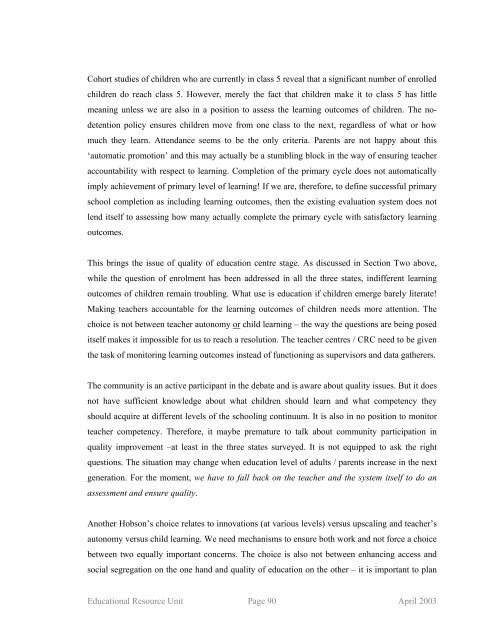Snakes and Ladders - ERU Consultants Pvt. Ltd.
Snakes and Ladders - ERU Consultants Pvt. Ltd.
Snakes and Ladders - ERU Consultants Pvt. Ltd.
You also want an ePaper? Increase the reach of your titles
YUMPU automatically turns print PDFs into web optimized ePapers that Google loves.
Cohort studies of children who are currently in class 5 reveal that a significant number of enrolled<br />
children do reach class 5. However, merely the fact that children make it to class 5 has little<br />
meaning unless we are also in a position to assess the learning outcomes of children. The no-<br />
detention policy ensures children move from one class to the next, regardless of what or how<br />
much they learn. Attendance seems to be the only criteria. Parents are not happy about this<br />
‘automatic promotion’ <strong>and</strong> this may actually be a stumbling block in the way of ensuring teacher<br />
accountability with respect to learning. Completion of the primary cycle does not automatically<br />
imply achievement of primary level of learning! If we are, therefore, to define successful primary<br />
school completion as including learning outcomes, then the existing evaluation system does not<br />
lend itself to assessing how many actually complete the primary cycle with satisfactory learning<br />
outcomes.<br />
This brings the issue of quality of education centre stage. As discussed in Section Two above,<br />
while the question of enrolment has been addressed in all the three states, indifferent learning<br />
outcomes of children remain troubling. What use is education if children emerge barely literate!<br />
Making teachers accountable for the learning outcomes of children needs more attention. The<br />
choice is not between teacher autonomy or child learning – the way the questions are being posed<br />
itself makes it impossible for us to reach a resolution. The teacher centres / CRC need to be given<br />
the task of monitoring learning outcomes instead of functioning as supervisors <strong>and</strong> data gatherers.<br />
The community is an active participant in the debate <strong>and</strong> is aware about quality issues. But it does<br />
not have sufficient knowledge about what children should learn <strong>and</strong> what competency they<br />
should acquire at different levels of the schooling continuum. It is also in no position to monitor<br />
teacher competency. Therefore, it maybe premature to talk about community participation in<br />
quality improvement –at least in the three states surveyed. It is not equipped to ask the right<br />
questions. The situation may change when education level of adults / parents increase in the next<br />
generation. For the moment, we have to fall back on the teacher <strong>and</strong> the system itself to do an<br />
assessment <strong>and</strong> ensure quality.<br />
Another Hobson’s choice relates to innovations (at various levels) versus upscaling <strong>and</strong> teacher’s<br />
autonomy versus child learning. We need mechanisms to ensure both work <strong>and</strong> not force a choice<br />
between two equally important concerns. The choice is also not between enhancing access <strong>and</strong><br />
social segregation on the one h<strong>and</strong> <strong>and</strong> quality of education on the other – it is important to plan<br />
Educational Resource Unit Page 90 April 2003












